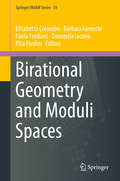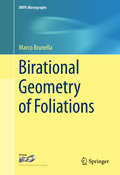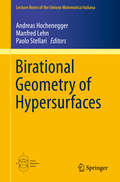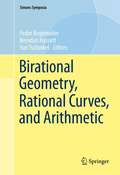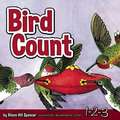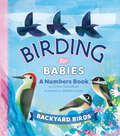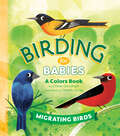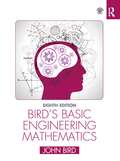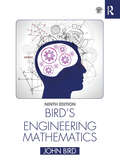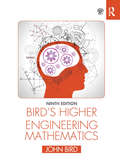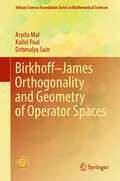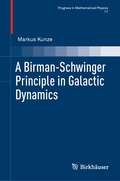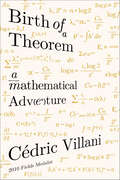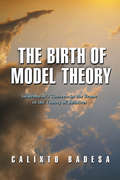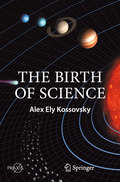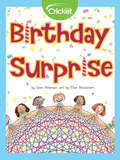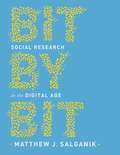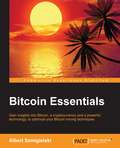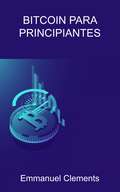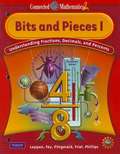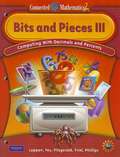- Table View
- List View
Birational Geometry and Moduli Spaces (Springer INdAM Series #39)
by Rita Pardini Elisabetta Colombo Barbara Fantechi Paola Frediani Donatella IaconoThis volume collects contributions from speakers at the INdAM Workshop “Birational Geometry and Moduli Spaces”, which was held in Rome on 11–15 June 2018. The workshop was devoted to the interplay between birational geometry and moduli spaces and the contributions of the volume reflect the same idea, focusing on both these areas and their interaction. In particular, the book includes both surveys and original papers on irreducible holomorphic symplectic manifolds, Severi varieties, degenerations of Calabi-Yau varieties, uniruled threefolds, toric Fano threefolds, mirror symmetry, canonical bundle formula, the Lefschetz principle, birational transformations, and deformations of diagrams of algebras. The intention is to disseminate the knowledge of advanced results and key techniques used to solve open problems. The book is intended for all advanced graduate students and researchers interested in the new research frontiers of birational geometry and moduli spaces.
Birational Geometry of Foliations (IMPA Monographs #1)
by Marco BrunellaThe text presents the birational classification of holomorphic foliations of surfaces. It discusses at length the theory developed by L. G. Mendes, M. McQuillan and the author to study foliations of surfaces in the spirit of the classification of complex algebraic surfaces.
Birational Geometry of Hypersurfaces: Gargnano del Garda, Italy, 2018 (Lecture Notes of the Unione Matematica Italiana #26)
by Andreas Hochenegger Manfred Lehn Paolo StellariOriginating from the School on Birational Geometry of Hypersurfaces, this volume focuses on the notion of (stable) rationality of projective varieties and, more specifically, hypersurfaces in projective spaces, and provides a large number of open questions, techniques and spectacular results. The aim of the school was to shed light on this vast area of research by concentrating on two main aspects: (1) Approaches focusing on (stable) rationality using deformation theory and Chow-theoretic tools like decomposition of the diagonal; (2) The connection between K3 surfaces, hyperkähler geometry and cubic fourfolds, which has both a Hodge-theoretic and a homological side. Featuring the beautiful lectures given at the school by Jean-Louis Colliot-Thélène, Daniel Huybrechts, Emanuele Macrì, and Claire Voisin, the volume also includes additional notes by János Kollár and an appendix by Andreas Hochenegger.
Birational Geometry, Rational Curves, and Arithmetic (Simons Symposia)
by Yuri Tschinkel Fedor Bogomolov Brendan HassettThis book features recent developments in a rapidly growing area at the interface of higher-dimensional birational geometry and arithmetic geometry. It focuses on the geometry of spaces of rational curves, with an emphasis on applications to arithmetic questions. Classically, arithmetic is the study of rational or integral solutions of diophantine equations and geometry is the study of lines and conics. From the modern standpoint, arithmetic is the study of rational and integral points on algebraic varieties over nonclosed fields. A major insight of the 20th century was that arithmetic properties of an algebraic variety are tightly linked to the geometry of rational curves on the variety and how they vary in families. This collection of solicited survey and research papers is intended to serve as an introduction for graduate students and researchers interested in entering the field, and as a source of reference for experts working on related problems. Topics that will be addressed include: birational properties such as rationality, unirationality, and rational connectedness, existence of rational curves in prescribed homology classes, cones of rational curves on rationally connected and Calabi-Yau varieties, as well as related questions within the framework of the Minimal Model Program.
Bird Count (Adventure Boardbook Series 1-2-3)
by Alison Hill SpencerGrowing up with a father who cherished birds and traveled the world with ornithologists on birding trips, Alison Spencer has always enjoyed birds. Unable to find children's books that depicted realistic birds, she decided to create her own. This delightful, colorful book not only introduces kids to birds they might see but also reinforces count concepts. Images removed.
Birding for Babies: A Numbers Book
by Chloe GoodhartIntroducing a new board book series, filled with fun facts, that invites young readers into the exciting world of bird-watching.From two red-bellied woodpeckers to eight northern mockingbirds, kids will explore some of the most popular backyard birds nature has to offer while learning their numbers, too! The whole family can bring these books outdoors and bird together!
Birding for Babies: A Colors Book
by Chloe GoodhartIntroducing a new board book series, filled with fun facts, that invites young readers into the exciting world of bird-watching.From the purple finch to the Indigo bunting, kids will explore some of the most popular migrating birds nature has to offer while learning their unique colors, too! The whole family can bring these books outdoors and bird together!
Bird's Basic Engineering Mathematics
by John BirdNow in its eighth edition, Bird’s Basic Engineering Mathematics has helped thousands of students to succeed in their exams. Mathematical theories are explained in a straightforward manner, supported by practical engineering examples and applications to ensure that readers can relate theory to practice. Some 1,000 engineering situations/problems have been ‘flagged-up’ to help demonstrate that engineering cannot be fully understood without a good knowledge of mathematics. The extensive and thorough coverage makes this a great text for introductory level engineering courses – such as for aeronautical, construction, electrical, electronic, mechanical, manufacturing engineering and vehicle technology – including for BTEC First, National and Diploma syllabuses, City & Guilds Technician Certificate and Diploma syllabuses, and even for GCSE revision. Its companion website provides extra materials for students and lecturers, including full solutions for all 1,700 further questions, lists of essential formulae, multiple choice tests, and illustrations, as well as full solutions to revision tests for course instructors.
Birds, Bees and Burgers: Puzzling Geometry from EnigMaths
by Paulo FerroProblems are presented simply and colorfully, and solutions are well expounded and clear. The reader will enjoy the challenge, and the "aha" moment of understanding any solution that they did not come to themselves. Great fun—and enlightening, too!
Bird's Engineering Mathematics
by John BirdNow in its ninth edition, Bird’s Engineering Mathematics has helped thousands of students to succeed in their exams. Mathematical theories are explained in a straightforward manner, supported by practical engineering examples and applications to ensure that readers can relate theory to practice. Some 1,300 engineering situations/problems have been ‘flagged-up’ to help demonstrate that engineering cannot be fully understood without a good knowledge of mathematics. The extensive and thorough topic coverage makes this a great text for a range of level 2 and 3 engineering courses – such as for aeronautical, construction, electrical, electronic, mechanical, manufacturing engineering and vehicle technology – including for BTEC First, National and Diploma syllabuses, City & Guilds Technician Certificate and Diploma syllabuses, and even for GCSE and A-level revision. Its companion website at www.routledge.com/cw/bird provides resources for both students and lecturers, including full solutions for all 2,000 further questions, lists of essential formulae, multiple-choice tests, and illustrations, as well as full solutions to revision tests for course instructors.
Bird's Higher Engineering Mathematics
by John BirdNow in its ninth edition, Bird’s Higher Engineering Mathematics has helped thousands of students to succeed in their exams. Mathematical theories are explained in a straightforward manner, supported by practical engineering examples and applications to ensure that readers can relate theory to practice. Some 1,200 engineering situations/problems have been ‘flagged-up’ to help demonstrate that engineering cannot be fully understood without a good knowledge of mathematics. The extensive and thorough topic coverage makes this an ideal text for undergraduate degree courses, foundation degrees, and for higher-level vocational courses such as Higher National Certificate and Diploma courses in engineering disciplines. Its companion website at www.routledge.com/cw/bird provides resources for both students and lecturers, including full solutions for all 2,100 further questions, lists of essential formulae, multiple-choice tests, and illustrations, as well as full solutions to revision tests for course instructors.
Birkhoff–James Orthogonality and Geometry of Operator Spaces (Infosys Science Foundation Series)
by Arpita Mal Kallol Paul Debmalya SainThis book provides an insight into the geometric aspects of the spaces of operators studied by using the notion of Birkhoff–James orthogonality. It studies the norm attainment set of an operator and its properties, the notion of which plays a very important role in the characterization of B-J orthogonality of operators. The structure of the norm attainment set is studied for Hilbert space operators and is yet to be understood completely for operators between Banach spaces. The book explores the interrelation between B-J orthogonality in the ground space and in the space of operators in its fullest generality. The book further explores the concept of approximate B-J orthogonality and investigated its geometry both in the ground space as well as in the space of operators. It highlights important geometric properties like smoothness and k-smoothness of bounded linear operators, extreme contractions and symmetricity of bounded linear operators defined between Hilbert spaces as well as Banach spaces.
A Birman-Schwinger Principle in Galactic Dynamics (Progress in Mathematical Physics #77)
by Markus KunzeThis monograph develops an innovative approach that utilizes the Birman-Schwinger principle from quantum mechanics to investigate stability properties of steady state solutions in galactic dynamics. The opening chapters lay the framework for the main result through detailed treatments of nonrelativistic galactic dynamics and the Vlasov-Poisson system, the Antonov stability estimate, and the period function $T_1$. Then, as the main application, the Birman-Schwinger type principle is used to characterize in which cases the “best constant” in the Antonov stability estimate is attained. The final two chapters consider the relation to the Guo-Lin operator and invariance properties for the Vlasov-Poisson system, respectively. Several appendices are also included that cover necessary background material, such as spherically symmetric models, action-angle variables, relevant function spaces and operators, and some aspects of Kato-Rellich perturbation theory. A Birman-Schwinger Principle in Galactic Dynamics will be of interest to researchers in galactic dynamics, kinetic theory, and various aspects of quantum mechanics, as well as those in related areas of mathematical physics and applied mathematics.
Birth of a Theorem: A Mathematical Adventure
by Cédric VillaniIn 2010, French mathematician Cédric Villani received the Fields Medal, the most coveted prize in mathematics, in recognition of a proof which he devised with his close collaborator Clément Mouhot to explain one of the most surprising theories in classical physics. Birth of aTheorem is Villani's own account of the years leading up to the award. It invites readers inside the mind of a great mathematician as he wrestles with the most important work of his career.But you don't have to understand nonlinear Landau damping to love Birth of aTheorem. It doesn't simplify or overexplain; rather, it invites readers into collaboration. Villani's diaries, emails, and musings enmesh you in the process of discovery. You join him in unproductive lulls and late-night breakthroughs. You're privy to the dining-hall conversations at the world's greatest research institutions. Villani shares his favorite songs, his love of manga, and the imaginative stories he tells his children. In mathematics, as in any creative work, it is the thinker's whole life that propels discovery—and with Birth of aTheorem, Cédric Villani welcomes you into his.
The Birth of Model Theory: Löwenheim's Theorem in the Frame of the Theory of Relatives
by Calixto BadesaLöwenheim's theorem reflects a critical point in the history of mathematical logic, for it marks the birth of model theory--that is, the part of logic that concerns the relationship between formal theories and their models. However, while the original proofs of other, comparably significant theorems are well understood, this is not the case with Löwenheim's theorem. For example, the very result that scholars attribute to Löwenheim today is not the one that Skolem--a logician raised in the algebraic tradition, like Löwenheim--appears to have attributed to him. In The Birth of Model Theory, Calixto Badesa provides both the first sustained, book-length analysis of Löwenheim's proof and a detailed description of the theoretical framework--and, in particular, of the algebraic tradition--that made the theorem possible. Badesa's three main conclusions amount to a completely new interpretation of the proof, one that sharply contradicts the core of modern scholarship on the topic. First, Löwenheim did not use an infinitary language to prove his theorem; second, the functional interpretation of Löwenheim's normal form is anachronistic, and inappropriate for reconstructing the proof; and third, Löwenheim did not aim to prove the theorem's weakest version but the stronger version Skolem attributed to him. This book will be of considerable interest to historians of logic, logicians, philosophers of logic, and philosophers of mathematics.
The Birth of Science (Springer Praxis Books)
by Alex Ely KossovskyThis book reveals the multi-generational process involved in humanity's first major scientific achievement, namely the discovery of modern physics, and examines the personal lives of six of the intellectual giants involved. It explores the profound revolution in the way of thinking, and in particular the successful refutation of the school of thought inherited from the Greeks, which focused on the perfection and immutability of the celestial world. In addition, the emergence of the scientific method and the adoption of mathematics as the central tool in scientific endeavors are discussed. The book then explores the delicate thread between pure philosophy, grand unifying theories, and verifiable real-life scientific facts. Lastly, it turns to Kepler’s crucial 3rd law and shows how it was derived from a mere six data points, corresponding to the six planets known at the time. Written in a straightforward and accessible style, the book will inform and fascinate all aficionados of science, history, philosophy, and, in particular, astronomy.
Birthday Surprise
by Ivars PetersonIf your class has 23 or more students, there's more than a 50% chance that two or more students share a birthday. How is this possible? Learn about probability with this simple exercise.
Bit by Bit: Social Research in the Digital Age
by Matthew J. SalganikAn innovative and accessible guide to doing social research in the digital ageIn just the past several years, we have witnessed the birth and rapid spread of social media, mobile phones, and numerous other digital marvels. In addition to changing how we live, these tools enable us to collect and process data about human behavior on a scale never before imaginable, offering entirely new approaches to core questions about social behavior. Bit by Bit is the key to unlocking these powerful methods—a landmark book that will fundamentally change how the next generation of social scientists and data scientists explores the world around us.Bit by Bit is the essential guide to mastering the key principles of doing social research in this fast-evolving digital age. In this comprehensive yet accessible book, Matthew Salganik explains how the digital revolution is transforming how social scientists observe behavior, ask questions, run experiments, and engage in mass collaborations. He provides a wealth of real-world examples throughout and also lays out a principles-based approach to handling ethical challenges.Bit by Bit is an invaluable resource for social scientists who want to harness the research potential of big data and a must-read for data scientists interested in applying the lessons of social science to tomorrow’s technologies.Illustrates important ideas with examples of outstanding researchCombines ideas from social science and data science in an accessible style and without jargonGoes beyond the analysis of “found” data to discuss the collection of “designed” data such as surveys, experiments, and mass collaborationFeatures an entire chapter on ethicsIncludes extensive suggestions for further reading and activities for the classroom or self-study
Bitangential Direct and Inverse Problems for Systems of Integral and Differential Equations
by Damir Z. Arov Harry DymThis largely self-contained treatment surveys, unites and extends some 20 years of research on direct and inverse problems for canonical systems of integral and differential equations and related systems. Five basic inverse problems are studied in which the main part of the given data is either a monodromy matrix; an input scattering matrix; an input impedance matrix; a matrix valued spectral function; or an asymptotic scattering matrix. The corresponding direct problems are also treated. The book incorporates introductions to the theory of matrix valued entire functions, reproducing kernel Hilbert spaces of vector valued entire functions (with special attention to two important spaces introduced by L. de Branges), the theory of J-inner matrix valued functions and their application to bitangential interpolation and extension problems, which can be used independently for courses and seminars in analysis or for self-study. A number of examples are presented to illustrate the theory.
Bitcoin Essentials
by Albert Szmigielski<p>Blockchain is being billed as the technology of the future. Bitcoin is the first application of that technology. Mining is what makes it all possible. Exploring mining from a practical perspective will help you make informed decisions about your mining setup. Understanding what the future may hold for blockchains, and therefore for mining, will help you position yourself to take advantage of the impending changes. <p>This practical guide starts with an introduction to Bitcoin wallets, as well as mining hardware and software. You will move on to learn about different mining techniques using the CPU, GPU, FPGA, and ultimately the ASIC as an example. After this, you will gain an insight into solo mining and pool mining, and see the differences between the two. The book will then walk you through large-scale mining and the challenges faced during such operations. Finally, you will take a look into the future to see a world where blockchain-based applications are commonplace and mining is ubiquitous.</p>
Bitcoin para principiantes
by Emmanuel ClementsBITCOIN PARA PRINCIPIANTES: La guía completa para principiantes para aprender, entender y explorar el mundo de Bitcoin en 2019 - Entender el poder de la tecnología de criptocurrency. Bitcoin es una criptocurrency creada en 2009. Los mercados denominados "bolsas de monedas" permiten a la gente comprar o vender monedas con diferentes monedas. Bitcoin es una nueva moneda que fue creada en 2009 por un desconocido con el alias de Satoshi Nakamoto. Las transacciones se realizan sin intermediarios, es decir, sin bancos. Bitcoin se puede utilizar para reservar hoteles en Expedia, comprar muebles en Overstock y comprar juegos de Xbox. Pero gran parte del bombo se trata de enriquecerse con el comercio. El precio del bitcoin se disparó a miles en 2017.
Bits and Pieces 1: Understanding Fractions, Decimals, and Percents (Texas)
by Glenda Lappan James T. Fey William M. Fitzgerald Susan N. Friel Elizabeth Difanis Phillips Michelle BarberaNIMAC-sourced textbook
Bits and pieces I, Understanding Fractions, Decimals, and Percents
by Glenda Lappan James T. Fey William M. Fitzgerald Susan N. Friel Elizabeth Difanis PhillipsNIMAC-sourced textbook
Bits and Pieces II Using Fraction Operations
by Glenda Lappan James T. Fey William M. FitzgeraldNIMAC-sourced textbook
